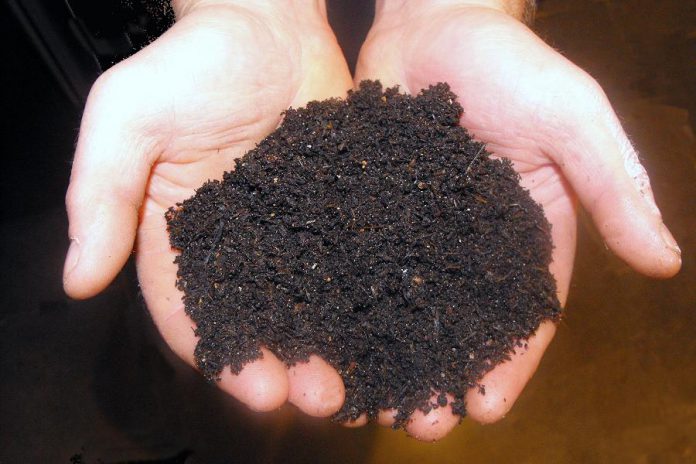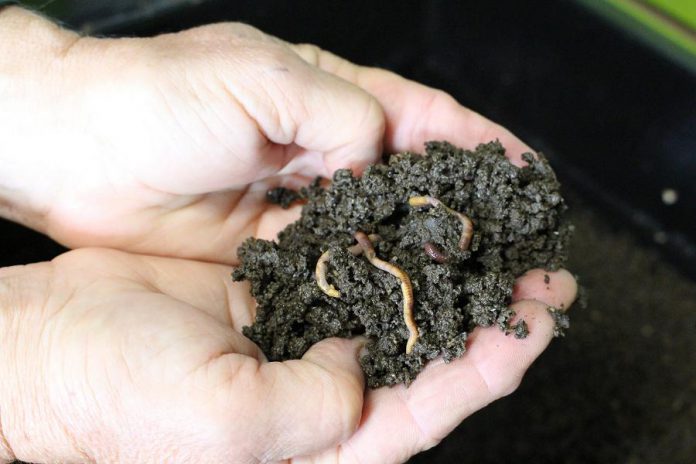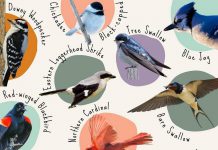
Vermicomposting is the use of Red Wiggler worms to convert kitchen and lunchroom waste into natural fertilizer. Worm castings benefit your garden and house plants and reduce the amount of green waste going to our local landfill. Vermicomposting is ideal for classrooms, office lunchrooms, and apartment living.
It was back in my second year of university, and my third year of apartment living, when I first experimented with vermicomposting. I was looking for ways to reduce the amount of garbage I placed at the curb each week.
It felt a bit strange considering having worms as roommates — but without a backyard, I was unable to compost outside.
Worms, specifically Red Wigglers, are efficient at breaking down and transforming food scraps quickly into compost as they pass through the worm’s body. Red Wigglers are not the type of worms we see in the garden, but are a smaller, slimmer-bodied worm with a red body that cannot survive outdoors in our Ontario winters.
Red Wigglers are not usually found at bait shops, so they must be specially ordered for compost bins. Locally, GreenUP Ecology Park will be holding a vemicomposting workshop on Saturday, September 24th, which will include Red Wigglers, along with a worm bin and two hours of instruction to get you started.
Worm bins are also available at the GreenUP Store; vermicomposting has become much more popular and there are now several bin options available depending on your budget, volume of compost, and number of people contributing scraps to the bin. But for my first bin, I had to improvise.
I cut a hole in the side of a Rubbermaid container and glued a screen in the side to allow for ventilation. I added some shredded newspaper and a bit of soil as bedding, added my Red Wigglers, and secured the lid. The bin fit perfectly under my sink where light was limited, and it was out of the way.
Worms will eat almost anything that humans will, but I learned quickly that much like an outdoor composter, meat, bones, cheese, or anything with cooking oil on it, should not be placed in an indoor vermicomposter — the odours were quite unpleasant. Stick to feeding the worms veggie scraps, eggshells, and fruits.
Once I got the hang of it, feeding worms in the bin was quite easy and they only needed to be fed once or twice per week. Each time I fed them, I checked the moisture level to ensure that it wasn’t too dry or too wet.

Ideally, the bedding should be as moist as a wrung-out sponge. If the bin gets too wet, then there is likely too much food for the number of worms in the bin, and the bin may be too small for the quantity being added. That is when worms may try to vacate the bin. Classrooms and larger office lunchrooms may need to consider multiple bins to accommodate the volume of scraps being added.
I never had any escapees, but another challenge I faced was pesky fruit flies. I managed to get them under control by changing my feeding technique by lifting up the bedding material and placing the food scraps an inch or more below the surface, instead of just on top. The worms were then able to consume their meal where they were buried and the fruit flies quickly disappeared.
Even though I went through a few bumps learning how to vermicompost on my own, I certainly reaped the benefits once I had accumulated some worm castings. After earthworms digest the scraps, the rich, organic matter that is excreted is a nutrient rich waste that is great for plants.
Worm castings are 100% organic and are full of nutrients that are easily absorbed by plant roots. They also contain microbes that help your plants become more disease resistant and better able to repel pests.
There are a few methods for harvesting worm castings. I have tried a few ways but my favourite is to chose a warm, sunny day and spread the contents of the bin outside on a plastic sheet. Since worms do not like the light, they move deeper into the pile. Then, castings can be removed from the outer edges.
GreenUP Ecology Park’s upcoming vermicomposting workshop is on Saturday, September 24th from 1 to 3 p.m. The deadline to register is September 19th. For workshop details and to register, please visit www.greenup.on.ca. For questions, please contact us at workshops@greenup.on.ca.


























